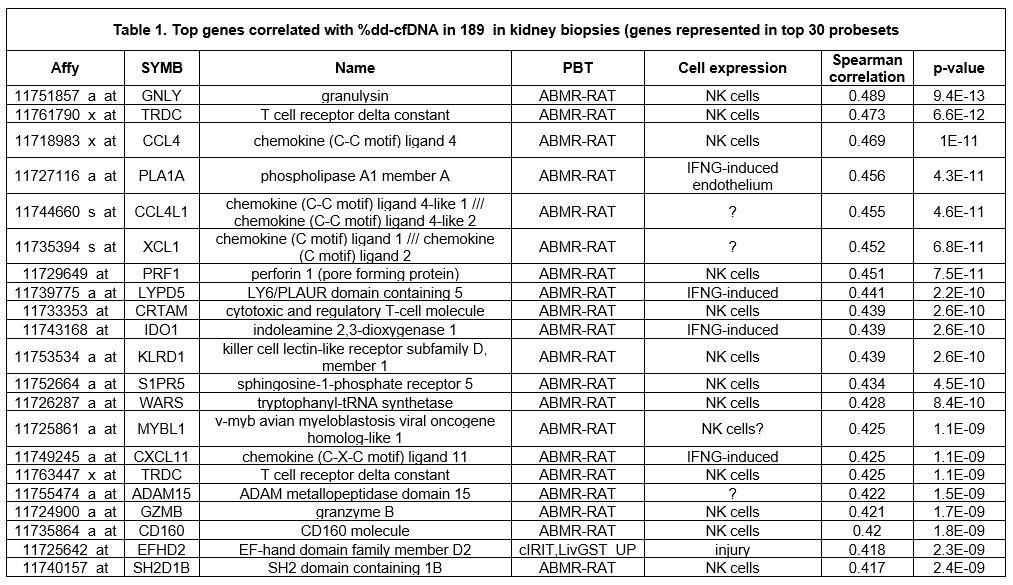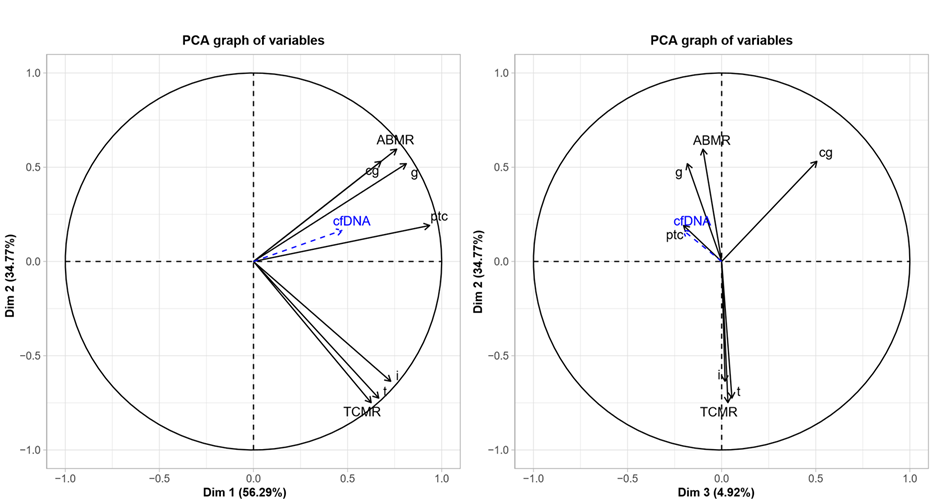The Trifecta Study: Calibrating Circulating Donor-Derived Cell-Free DNA at the Time of Indication Biopsies Against the Molecular Phenotype of the Biopsy Reveals a Prominent Association with NK Cell Genes
1Alberta Transplant Applied Genomics Centre, Edmonton, AB, Canada, 2Natera Inc., San Carlos, CA
Meeting: 2021 American Transplant Congress
Abstract number: 322
Keywords: Alloantibodies, Kidney transplantation, Rejection, Renal dysfunction
Topic: Clinical Science » Kidney » Kidney Acute Antibody Mediated Rejection
Session Information
Session Name: Kidney Antibody Mediated Rejection
Session Type: Rapid Fire Oral Abstract
Date: Tuesday, June 8, 2021
Session Time: 4:30pm-5:30pm
 Presentation Time: 4:55pm-5:00pm
Presentation Time: 4:55pm-5:00pm
Location: Virtual
*Purpose: The international, multicenter, prospective Trifecta study was designed to calibrate dd-cfDNA% measurements in blood at the time of indication biopsy against the molecular characteristics of the biopsies using the Molecular Microscope® (MMDx) (ClinicalTrials.gov NCT04239703).
*Methods: MMDx was used to assess TCMR, ABMR, acute kidney injury, atrophy-fibrosis, and genome-wide gene expression in the biopsy samples. dd-cfDNA% assays (Prospera) were performed on blood samples by Natera. We analyzed 189 biopsies from 14 centers. By MMDx, the diagnoses were: No rejection 104; ABMR 43; Possible ABMR 16; Mixed 7; TCMR 14 (5 with histologic BK); Possible TCMR 5.
*Results: The 20 genes most strongly correlated with dd-cfDNA% are shown in Table 1. Most (20/21) were genes annotated as ABMR-rejection associated (ABMR-RATs) from previous studies. Most were expressed in NK cells (GNLY TRDC, CCL4) or represented IFNG effects (PLA1A, LYPD5 (LY6), IDO1, CXCL11). Endothelium-expressed genes were not prominent. By MMDx diagnosis, dd-cfDNA% was strongly related to active early stage- and fully-developed ABMR. In principal component analysis (Figure 1) using rejection classifiers as inputs, dd-cfDNA% correlated with ABMR in PC1 and PC2, and with early stage and fully developed ABMR in PC3. The results were less consistent in TCMR, and some biopsies with no MMDx rejection had high %dd-cfDNA scores. Mean scores were somewhat higher in very early biopsies and in late biopsies, increasing with time of biopsy post-transplant, but there were no strong correlations with injury or with atrophy-fibrosis. The AUCs of %dd-cfDNA for rejection were higher for MMDx than histologic rejection.
*Conclusions: Results in 189 Trifecta indication biopsy reveal that dd-cfDNA% at time of biopsy is strongly related to the active ABMR processes in the biopsy but particularly NK cell genes and IFNG-induced genes.
To cite this abstract in AMA style:
Halloran P, Demko Z, Prewett A, Reeve J, Billings P. The Trifecta Study: Calibrating Circulating Donor-Derived Cell-Free DNA at the Time of Indication Biopsies Against the Molecular Phenotype of the Biopsy Reveals a Prominent Association with NK Cell Genes [abstract]. Am J Transplant. 2021; 21 (suppl 3). https://atcmeetingabstracts.com/abstract/the-trifecta-study-calibrating-circulating-donor-derived-cell-free-dna-at-the-time-of-indication-biopsies-against-the-molecular-phenotype-of-the-biopsy-reveals-a-prominent-association-with-nk-cell-ge/. Accessed January 1, 2026.« Back to 2021 American Transplant Congress


